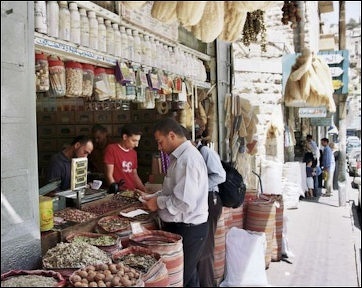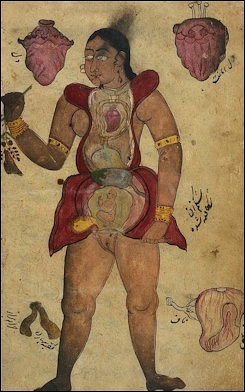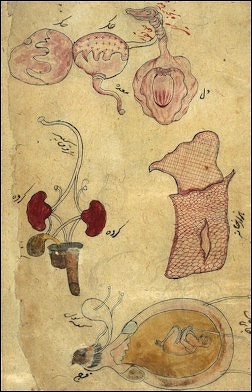Home | Category: Muslim Food, Sex and Drugs / Muslim Education, Government and Finance / Arab Life, Marriage, Family and Funerals
TRADITIONAL ARAB-MUSLIM HEALERS AND MEDICINE

Arabic medicine stall in Amman, Jordan
In the old days people relied on folk medicine. Arab herbalists treat everything from infertility to impotence to heart problems with leaves, moss, live chameleons, pieces or coral, desiccated seeds, crushed herbs and ground up sea horses, sea urchins and sea turtles.
Muslim healers often find verses in the Qur’an to go along with their treatments. Describing a healer in Niger, Eigen Richards wrote in Natural History: "He writes out the verse on a wooden prayer board, using ink made from tree bark. The patient must was wash the words off with water in a bowl, then drink it. For chronic problems he writes verses on paper that is then sewn into a leather pouch that is worn around the neck, waist ankle or wrist."
One “ hadith” recommends that illnesses be treated by taking honey, cupping and cauterization. Cupping is the draining of blood from the hands, legs or head. Muhammad was once cupped while he was fasting. Cauterization is the use of a burning hot piece of iron to stop bleeding. In ancient times this practice was used among soldiers who lost an arm or leg in battle to keep them from bleeding to death.
In Egypt the most common potions are those are prescribed to take off weight and the greatest demand is during Ramadan—the Muslim month of day time fasting—when Muslim gorge themselves with sweets, stuffed peppers, puddings and lentil soup at night. One fat-reducing potion is a boiled tea made from a red powders taken twice a day. Another is a leafy cold drink consumed three times a day.
Without access to doctors, people have relied on herbs, amulets and invocations. Traditional medicines in Yemen include resin from the dragon blood tree; a bright yellow tumeric used as sunscreen and cosmetic; “ myrrh”, for female disorders “ hilf”, small red seeds used to treat kidney stones; ground red coral for healing cuts and various other curative barks, galls, herbs, seaweed and fish scales. [Source: Thomas Abercrombie, National Geographic, October 1985]
Websites and Resources: Islam IslamOnline islamonline.net ; Institute for Social Policy and Understanding ispu.org; Islam.com islam.com ; Islamic City islamicity.com ; BBC article bbc.co.uk/religion/religions/islam ; University of Southern California Compendium of Muslim Texts web.archive.org ; Encyclopædia Britannica article on Islam britannica.com ; Islam at Project Gutenberg gutenberg.org ; Muslims: PBS Frontline documentary pbs.org frontline
Websites and Resources: Arabs: Wikipedia article Wikipedia ; Who Is an Arab? africa.upenn.edu ; Encyclopædia Britannica article britannica.com ; Arab Cultural Awareness fas.org/irp/agency/army ; Arab Cultural Center arabculturalcenter.org ; 'Face' Among the Arabs, CIA cia.gov/library/center-for-the-study-of-intelligence ; Arab American Institute aaiusa.org/arts-and-culture ; Introduction to the Arabic Language al-bab.com/arabic-language ; Wikipedia article on the Arabic language Wikipedia
RECOMMENDED BOOKS:
“Medicine of the Prophet” by Ibn Qayyim al-Jawziyya and Penelope Johnstone Amazon.com ;
“Encyclopedia of Islamic Herbal Medicine” by John Andrew Morrow Amazon.com ;
“Unani: The Science of Graeco Arabic Medicine” by Jamil Ahmad Amazon.com ;
“Fifty Hadeeth on Personal Hygiene & Ritual Purification” Amazon.com ;
“The Importance of Health and Hygiene in Islam” by Muhammad Bin Ibrahim Al-Hamad Amazon.com ;
“The Lawful and the Prohibited in Islam (Al-Halal Wal Haram Fil Islam) by Yusuf Al-Qaradawi Amazon.com ;
“Essential Duas in the Life of a Muslim” by Jamiatul Ulama Amazon.com ;
“Unveiling Islam: An Insider's Look at Muslim Life and Beliefs” by Ergun Caner and Emir Fethi Caner Amazon.com ;
“A Muslim Boy's Guide to Life's Big Changes” by Sami Khan and Abia Afsar-Siddiqui Amazon.com ;
“Make Wudu & Salah Like the Prophet, a Simple Step By Step Illustrative Guide” by Shaykh Muhammad S. Adly Amazon.com ;
“A Comprehensive List of Halal Food Products in US Supermarkets” Amazon.com ;
“Islam Explained: A Short Introduction to History, Teachings, and Culture” by Ahmad Rashid Salim Amazon.com ;
“Welcome to Islam: A Step-by-Step Guide for New Muslims” by Mustafa Umar Amazon.com
Health Problems in the Desert
If you are going to the desert make sure have eye protection (glasses or ski goggles), and something to cover you mouth and nose if necessary. It is not a bad idea to bring a surgical mask or painters mask. Desert winds can blow sand and grit into the eyes and mouth.

from an 18th century copy of the 15th century Medicine of Akbar
Getting some sand in one’s eyes can be a serious. Sometimes a layer of tissue will form over a congealed piece of sand. In addition to being extremely irritating it can cause permanent damage. Removing it can involve slitting the eye with a razor blade.
Dehydration is a serious problem in the hot desert. It is possible to die in less than four hours in wrong part of the desert at the wrong time. It goes without saying to bring lots of water, at least 5 liters per person a day, and have access to shade. To avoid heat exhaustion and heat stroke stay in shade as much as possible, get enough salt, replace electrolytes with fruit juices or prepared drinks that replace the salts you lose, stay out of the sun and don't do strenuous exercise after 10:00am and before 4:00pm.
Heat cramps are the least dangerous of the heat-related conditions. They serves as a warning that more serious things might happen. The symptoms include cramps, muscle twitching, and lightheadedness. If you have any of these symptoms immediately cool down your body with some water and shade.
Heat exhaustion is a serious condition. It is characterized by severe fatigue, headaches, confusion, nausea, weak pulse, cold clammy skin, and giddiness. Heat stroke is a very dangerous and potentially fatal condition characterized by a high body temperature and no sweating. People with heat stroke need immediate hospitalization; and should be cooled with wet towels until then.
Snakes and scorpions are mainly active at night. Bites from scorpions are often painful but rarely dangerous although some species can be dangerous. Snakes bites are generally a much more serious matter. Wearing thick boots is good preventative measure. Snakes and scorpions sometimes rest in shoes and clothes. It is a good idea to carefully shake your clothes and shoes before you put them on. There are antivenoms (antivenins) for most poisonous snakes but they are not always available. If you are really concerned you may want to bring snake anti-venom and scorpion anti-venom for the snakes and scorpions you might encounter. These sometimes need to refrigerated.
Unani Medicine
Unani (Greco–Arab medicine) is another ancient medical traditions that has its roots in ancient Greece and Rome and was developed under Muslims in the Middle East and was brought to the Indian subcontinent around the 10th century. Based on the principals of the Greek physician Galen and developed by the Arab philosopher Avicenna (A.D. 980-1037), it is based on the belief that food is transformed into natural warmth in the stomach with useful substances being distributed to parts of the body and waste eliminated.
According to Unani beliefs the main products of the food transformation process are the four humors: blood, mucus, yellow bile and black bile. These humors are combined with the four primary qualities: warmth, cold, moisture and dryness. If the four humors and four primary qualities are in balance a person is healthy. If there is disharmony among them then an ailment of some sort can occur. External factors such as climate, age, personal habits and professions can cause the dominance of one of the four humors.

from the Medicine of Akbar
Early Muslim rulers built hospitals that were based on the unani system. The system was spread far and wide by the Moguls, who lionized eminent physicians. Under the British, unani and ayuvedic medicine were ridiculed and regarded as inferior to Western medicine. Unani and ayuvedic were neglected among the elite but continued to be practiced in the countryside. Both systems were given a boost when nationalist movements in South Asia were launched in the late 19th century.
Islamic Medicine
A growing number of Muslims in Southeast Asia are turning away from Western medical care in favor of al-Tibb al-Nabawi, or Medicine of the Prophet, a loosely defined discipline based on the Quran and other Islamic texts and traditional herbal remedies. What is termed classical Islamic medicine developed in medieval times when it was regarded better than Western medicine in Christian Europe, and exerted a significant influence on it. Practitioners say many ingredients in today's treatments were used in Muhammad's time, including honey, olive oil, bee pollen, dates and black caraway seeds — which one ad claims is "a cure for every disease but death."
On the practice of 'Islamic Medicine' in Indonesia, Denis Gray of Associated Press wrote: “A 47-year-old housewife who recently started using Islamic medicine emerged tearfully from an exorcism, speaking of newfound tranquility after a turbulent period. Also, her abdominal pains are finally easing. Suratmi, who suffers from an ovarian cyst, has been taking a mix of herbal medicine harking back to the dawn of Islam, as well as undergoing exorcisms at a clinic in Jakarta. She is among a growing number of Muslims in Southeast Asia turning away from Western medical care in favor of al-Tibb al-Nabawi, or Medicine of the Prophet, a loosely defined discipline based on the Quran and other Islamic texts and traditional herbal remedies. "I heard that so many people have been healed, so I hope Allah can help me. I followed His path here," said Suratmi, who like many Indonesians goes by one name. [Source: Denis Gray, Associated Press, September 26 2011 ~/~]
“The Islamic medicine trend is often associated with fundamentalists who charge that Western, chemically laced prescriptions aim to poison Muslims or defile them with insulin and other medicines made from pigs. Members of terrorist groups have been involved in Islamic medicine as healers and sellers, while some clinics are used as recruiting grounds for Islamist causes. But the bulk of those seeking out Islamic clinics, hospitals and pharmacies, appear to be moderate Muslims, reflecting a rise in Islamic consciousness worldwide. "Islamic medicine carries a cachet that, by taking it, you are reinforcing your faith - and the profits go to Muslims," says Sidney Jones, an expert on Islam in Southeast Asia with the International Crisis Group. ~/~
“Islamic medicine, toiletries and beauty products have become a big business and industry's advertising can be just as gimmicky as any in the West. Capitalizing on the popularity of U.S. President Barack Obama, who spent four of his childhood years in Indonesia, one company produces a popular anti-stress concoction called Obahama - in a corruption of an Indonesian phrase for herbal medicine. Siwak-F, also exported to the Middle East, is hailed as "toothpaste just like the Prophet used to use." ~/~

from the Medicine of Akbar
“What is termed classical Islamic medicine developed in medieval times when it far outshone that in Christian Europe, and exerted a significant influence on it. Practitioners say many ingredients in today's treatments were used in Muhammad's time, including honey, olive oil, bee pollen, dates and black caraway - which one ad claims is "a cure for every disease but death." Brury Machendra, secretary-general of the Traditional Herbal Medicine Association of Indonesia, says most Indonesian Muslims don't doubt conventional medicine. But he says Indonesia's health services are so poor and expensive that many people seek out alternatives. Jemaah Islamiyah, an al-Qaida-linked militant network that is essentially banned in Indonesia, is believed to have links to some herbal manufacturers and operate many of the country's Islamic medicine clinics, International Crisis Group says.”~/~
“In Indonesia, traditional medicine really took off after a government promotional campaign in 2009, says Brury Machendra, owner of the Insani Herbal Clinic in suburban Jakarta where Suratmi and up to 400 other patients per month seek treatment. Only one such clinic existed in the Depok suburb two years ago, but now there are 20, with 70 others waiting for government permits. His clinic offers herbal medicine, a bloodletting treatment known as bekam and exorcisms in which a white-gloved therapist places a hand on a patient's head while chanting verses from the Quran.
“An exorcism costs about $12, while Machendra's government-certified herbal products such as the anticancer BioCarnoma and anti-diabetes BioGlukol go for no more than $5 for 60 capsules. He acknowledges that clinics such as his benefit from traditional Muslim rules forbidding certain ingredients and that many fundamentalists "tell people not to go to infidel doctors and say that buying Western medicine is forbidden." ~/~
Islamic Healers Treat Mental and Physical Wounds in Chechnya
In 2011, Reuters reported from war-torn Chechnya in Russia: Lying on a couch with her eyes closed, 26-year-old Milena sips water blessed by an Islamic healer who sits nearby reciting verses from the Qur’an to cure her depression. Outside, a long line of patients wait at Chechnya’s state-run Islamic Medical Center, hoping its staff can heal deep psychological wounds left by years of war....Milena is one of thousands of Chechens who have turned to traditional “Islamic” medicine for relief. [Source: Reuters, July 22, 2011]
The center in the mountainous territory has flourished alongside a resurgence of Islam encouraged by firebrand leader Ramzan Kadyrov after years of repression by secular Communist authorities. In a three-storey building in the Chechen capital Grozny, 11 healers prescribe treatments for anyone knocking on the door. “We take in about 150 people a day, and we work around the clock,” said Daud Selmurzayev, the head of the center. He said about 150,000 people had passed through the center’s doors since its opened two years ago to receive the treatments, popular among some branches of Islam but frowned upon by others.
Healing recitations of the Qur’an typically take about 30 minutes, he said. “People understand that the Qur’an represents the mercy of Allah and in it is the savior from many illnesses,” he said. Most patients are treated for depression or demonic possession, a commonly accepted affliction in Chechnya. Demand is so high the center is planning to open a new hospital in the region at the end of the Muslim holy month of Ramadan, due to start in Russia on August 1.
Psychologists and medical doctors practice in Chechnya but say their patients are held back by a culture of pride. Fear of punishment from authorities has also silenced complaints and prevented people from coming forward with their problems, say medical staff. Patients at the Islamic Medical Center receive treatment without having to talk directly about their issues.
“The number of people in our republic who suffer from increasing psychological disorders is related to the last two wars,” said mullah Alikhan. Like many Chechens, he also attributes the symptoms to evil spirits who he says are haunting the region. “Evil spirits usually live in hard to access places, now they are moving to cities and villages ... We have to look over our youth especially. Evil spirits as a rule target the youth just as they do the healthy,” said Alikhan, who declined to give his last name.
Image Sources: Wikimedia Commons
Text Sources: Internet Islamic History Sourcebook: sourcebooks.fordham.edu ; Arab News, Jeddah; “Islam, a Short History” by Karen Armstrong; “A History of the Arab Peoples” by Albert Hourani (Faber and Faber, 1991); “World Religions” edited by Geoffrey Parrinder (Facts on File Publications, New York); “Encyclopedia of the World’s Religions” edited by R.C. Zaehner (Barnes & Noble Books, 1959); Metropolitan Museum of Art, Encyclopedia.com, National Geographic, BBC, New York Times, Washington Post, Los Angeles Times, Smithsonian magazine, The Guardian, Al Jazeera, The New Yorker, Time, Newsweek, Reuters, Associated Press, AFP, Library of Congress and various books and other publications.
Last updated April 2024
